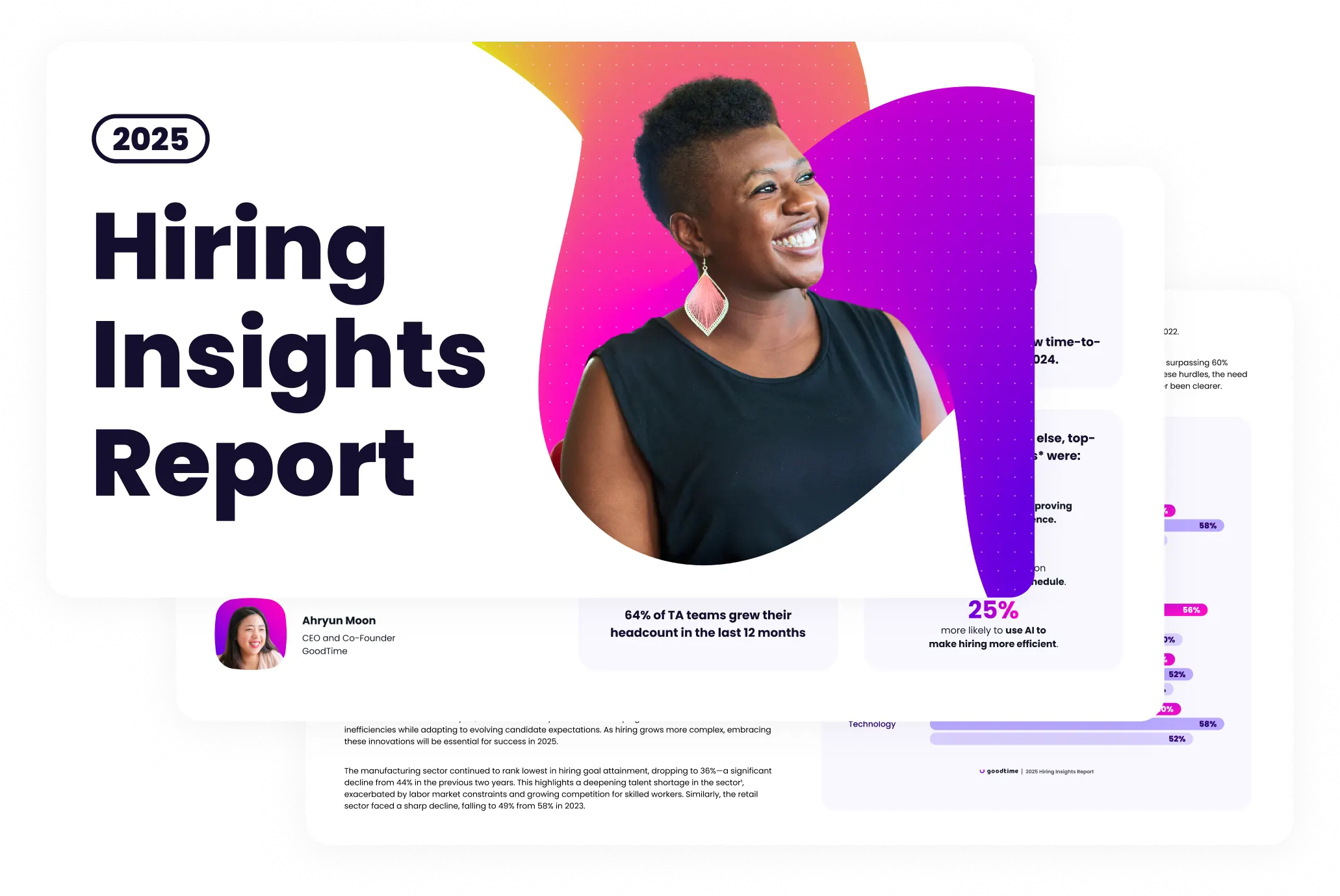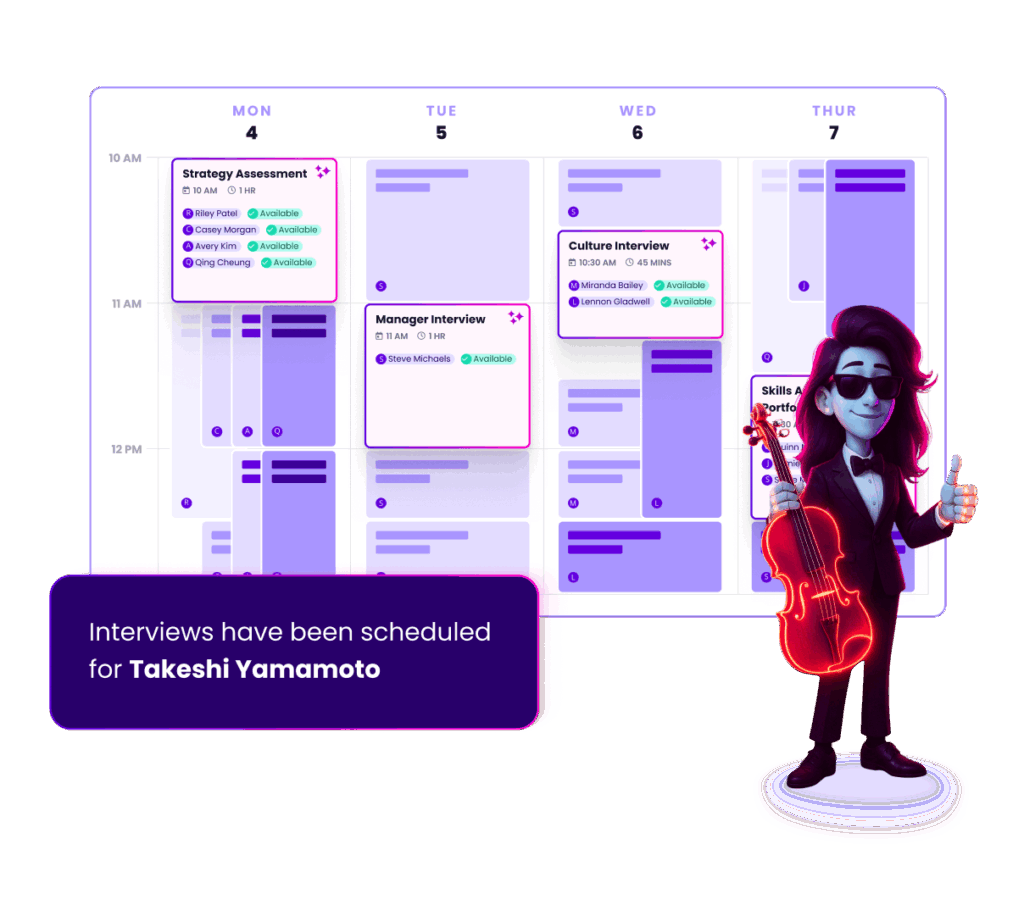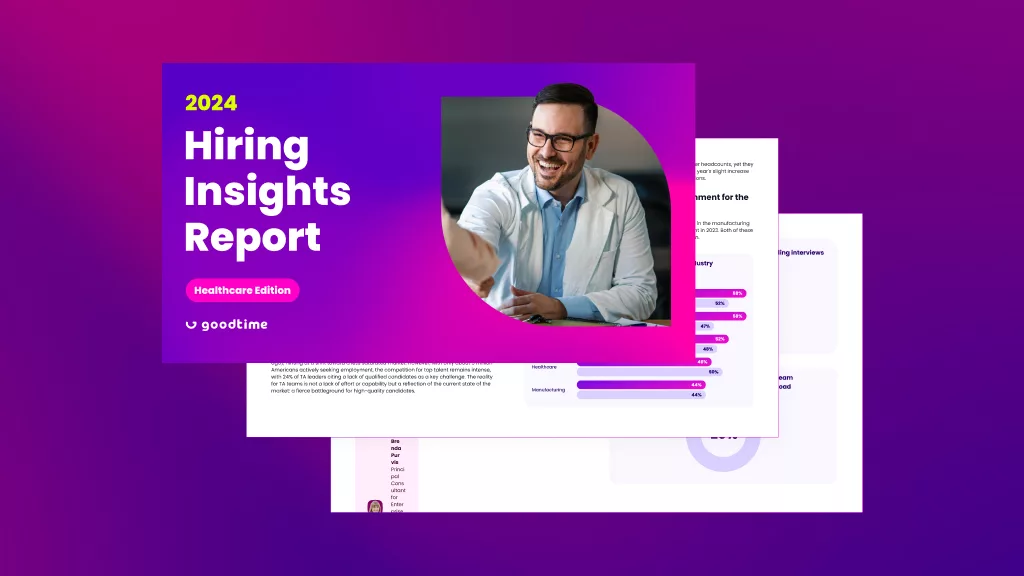The hiring process can make or break a successful company. Even if you have a fully staffed talent acquisition department equipped with advanced tools, the end-to-end process is often lengthy and complex.
You need to balance business needs with the candidate experience, speed with quality, and efficient technology with a human touch. None of that comes easily — especially with multiple stakeholders involved.
There’s a good chance you’re adding unnecessary steps when looking for the right candidate. What if, instead, you could feel confident you were leveraging only the most crucial hiring process steps?
The good news is, you can. By streamlining your recruiting and interview processes, you can remain thorough and provide a positive experience for candidates. Keep reading to learn what hiring process steps to keep, which to skip, and how to cultivate a top-notch process.
Challenges of a lengthy hiring process
A lengthy hiring process can result in a poor experience for the candidate and the potential to lose top talent. In fact, according to a LinkedIn report, 65% of candidates report losing interest in a job due to a poor interview experience.
Poor candidate experience
Regardless of whether a candidate is ultimately hired, their experience matters. Think of the golden rule — treat people how you’d hope to be treated.
Keep in mind that even when someone is no longer a job candidate, they might still be a consumer of your company’s product or service. It’s human nature to share poor experiences. Recent research reveals that 80% of candidates will spread the word about a poor interview experience, and a third of those will go out of their way to do so proactively. You may risk a hit to your reputation if candidates feel they’ve been treated unfairly.
Longer time to hire
Time to hire isn’t just an important recruiting metric. The more time you spend assessing and interviewing candidates, the longer your role remains open, extending the timeline to having a productive employee on staff. Plus, the longer a role remains vacant, the more work falls onto the remaining team members, which can negatively impact morale.
If you’re struggling with a long hiring process, you’re not alone. Last year, 44% of talent acquisition teams reported hiring took longer than the previous year. Just 10% of companies were able to hire faster than in the past.
Losing top talent
Overlong hiring processes also lead to a risk of losing top candidates. The most qualified talent tends to be in demand, and if they’re weighing several offers and still only halfway through your process, chances are they’re not going to wait around.
This not only puts you at risk of losing a top-performing hire, but it also provides an advantage to the competing company that lands the candidate. If top candidates are snatched up by other organizations, you may find yourself faced with the decision to either settle for a less qualified candidate or hold the role open even longer. Both of these have a negative impact on your team and goals.

Unlock 2025’s top hiring strategies: Insights from 500+ TA leaders
Be the first to uncover deep hiring insights specific to your sector — straight from the highest-performing TA teams.

8 essential steps to streamline your hiring process
Every company has its own unique way of hiring, but for a smooth hiring process, there are eight steps we recommend across the board.
1. Nail down your requirements
First things first: decide exactly what your business needs and how your future hire can fulfill those needs. Ask questions like these:
- What role will they play within the team?
- What duties will they have?
- What background and skills do they need to be successful?
For example, if you’re hiring for a senior backend software developer, you’re likely targeting someone with 7-10 years of experience in a backend-focused coding language who has led important projects and mentored other developers.
2. Hold an intake session
Before putting together a job posting, hold an intake meeting for the hiring managers and members of the recruitment team. This puts everybody on the same page regarding the expectations of the role.
Hiring managers should share their interview plan, including the required steps and responsible party. Recruiters can use this time to share insight into the talent landscape, such as the availability of professionals, top companies from which to recruit, and the best places to source candidates.
If the team anticipates a high volume of applicants, it can use the intake session to develop a rubric to help the recruiter determine who moves forward.
While the intake meeting is a great way to kick off a search, recruiters and hiring managers should remain in close communication throughout the hiring process, either with regular meetings or daily updates.
3. Craft and publish a job posting
Once you’re clear on what you’re looking for in an ideal candidate, it’s time to draft a job posting and share it with the world. If your company has a specific template to structure job postings, start with that.
Use the information you discussed in the intake meeting to create a job posting that highlights why the right candidate should be interested. Show them what’s in it for them. Don’t oversell or exaggerate the positives, but make sure you explain what’s exciting and unique about the position.
It’s equally important to describe the requirements you’re seeking. Often, this list includes:
- Years of experience
- Any degrees or certifications
- Particular skills or traits
Try to build a list of only objective qualities. You don’t want unnecessary biases to seep in.
Once ready, post the job on your company’s career site and other relevant sites like LinkedIn and niche job boards within your industry. You can also share the posting internally and ask members of the team to send it to promising candidates in their networks.
4. Generate and screen candidates
Once the job posting is live and the applications start pouring in, the talent acquisition team can begin reviewing and filtering resumes.
If there’s a high volume of candidates, you may be able to leverage AI tools to help filter through the resumes. To increase the likelihood of finding the best candidate, the recruiter may also source passive candidates who are not actively on the job hunt but could be a good fit.
To preserve hiring managers’ time and ensure only the best candidates move forward, recruiters should conduct an initial candidate screening conversation. This meeting, which can be done via phone or video, will give you a better idea of the candidate’s experience and their interest in the company and role, along with logistical details like compensation and location expectations.
5. Assess candidates’ skills
Depending on the position, many companies use skills assessments to get a deeper view into the candidate’s ability to perform the role, ensuring your final decision is based on more than just interviews. Per a LinkedIn report, 73% of recruiters listed skills-based hiring as a major priority.
These assessments can be explicitly skills-based, such as a coding assessment for a developer or a writing test for a communications professional. Avoid personality-based assessments, like the Myers–Briggs Type Indicator or DISC Assessment, as these are subjective.
Set a deadline for the candidate’s assessment. Give them a few business days to a week, depending on the project. Remember that waiting for an assessment can slow down the hiring process.
If the candidate doesn’t complete the assessment, whether due to time constraints or on principle, the recruiter should still attempt to get feedback from them. It may provide valuable insight into areas of improvement in the assessment process.
6. Interview the best candidates
The amount and length of interviews will vary based on the company and position. It’s not unheard of for large companies, especially in tech, to have five-hour interview days.
Before conducting interviews, the hiring team should have a detailed understanding of what to assess and how to do it. Prepare for success by:
- Holding a pre-interview strategy session to ensure clarity across the team
- Making sure each interviewer is knowledgeable about the position
- Assigning dedicated focus areas for each interviewer to avoid overlap and being unprepared
Like the job description, the interview questions should be free of bias and subjectivity. Each question should dig into the candidate’s ability to perform the job, not their personal traits.
7. Meet for debriefs
After each interviewer has completed their interviews and entered feedback into the system of record (this is frequently the ATS), the team should come together for a formal interview debrief.
Usually led by the recruiter, the debrief allows the panel to discuss their impressions of the candidate. Ideally, everyone should have read the others’ feedback before the meeting, so this time can be used to dive into deeper questions or concerns.
The goal of the debrief is to leave with a decision, whether that is to decline the candidate, make an offer, or move on to another interview.
8. Make your final selection and offer
After a candidate has completed the process and you’ve made your decision, the final hurdle is the offer process.
This varies by company, of course, but this should include:
- Identifying the correct level for the candidate (such as senior or principal)
- Finalizing the salary and any other perks and monetary offerings (such as bonuses or equity)
- Gathering any required approvals
- Crafting an offer letter
- Presenting the offer to the candidate
After the candidate receives the offer, they may negotiate for more money, increased vacation time, a signing bonus, or something else. The recruiter and hiring manager should partner with relevant HR stakeholders to determine any changes to the offer.
Strategies for an efficient hiring process
A quick, efficient hiring process does not have to compromise on quality. It’s often necessary to cut or alter parts of the process to ensure a better experience.
According to Monika Warchol, Talent Acquisition Operations Manager at Xcel Energy: “It’s about determining what the core problem is and then finding the shortest distance between the problem and the answer,” she says. “Sometimes it’s cutting a step out of a process, or even cutting a team out of a process, or a combination of things.”
Hiring process steps to skip
There are a few steps you can remove from your hiring process altogether, including cover letters, executive sign-off, and reference checks.
Forgo cover letters
A recent GoodTime poll found that 64% of talent acquisition professionals feel cover letters are unnecessary. While some recruiters will read them, most don’t feel it’s a valuable use of time.
To save recruiting time, simply eliminate the cover letter requirement. The bonus is that it saves the candidate time, too, and gives them more opportunity to tailor their resume to your job. If you really want to avoid dealing with cover letters entirely, you can set your system to only allow for resume uploads.
Skip top leadership sign-offs
Some companies have a requirement for top executives to sign off on every hire. This often holds up the process due to executives’ busy schedules. Plus, their lack of insight into the interview process often means they have to do extra research to understand the reason for the hire.
There are also cases where the compensation or HR team must sign off on every offer, even if it’s fully in-budget and within the salary range.
While you may have the option to automate the approval process via your applicant tracking or HR system, an even better approach is to put trust in the hiring managers for a majority of roles. This means avoiding executive approval — perhaps getting final approval from the skip-level manager or department head — and removing the need for HR approval unless there is an exception.
Remove the reference check
A reference check has long been seen as a way to gather data about how well an employee performs.
Reference checks may not be as helpful as they appear, however. For one thing, they can hold up the hiring process, especially if a reference is hard to reach. Also, most candidates will only list people who will speak positively about them, so you’re unlikely to get truly unbiased and objective information from any reference calls.
Instead, resolve to cultivate a stronger assessment process, such as leveraging behavioral interviewing to understand how a candidate has performed in the past.
Steps to improve
Per Valeria Stanga, Senior Talent Acquisition Partner with HelloFresh, there’s always an opportunity to improve your recruitment process. “Every day, you can re-evaluate your ways of working, you can re-evaluate the tools that you’re using, and you can look for new ways to work smarter instead of harder. There’s always something that you can do in a more efficient way,” she shared.
There are several ways to elevate aspects of the hiring process, including more targeted assessments, consolidated interviews, and the use of recruitment automation tools.
Focus your assessments
While an assessment can give you a view into a candidate’s ability to do the job, it’s important to use an assessment that is focused and not too long.
- Lengthy assessments hold up the interview process. They also impact a candidate’s experience. A better option is to leverage specific project assessments that align with the competencies established in the intake meeting.
- Avoid testing too many skills. Instead, include a brief project that directly shows how a candidate’s skills match those needed for the role. A more focused assessment should take less time for the candidate to complete and less time for your team to review.
- Remove personality tests from your process. These are subjective and not scientifically based. Instead, gain insight into an employee’s collaboration and communication skills through the interview process.
Consolidate interviews
There are several ways to consolidate the number of interviewers and interview rounds, such as:
- Designate a core interview panel that can assess different competencies. Then, assign specific focus areas to each interviewer. This gives you adequate coverage while avoiding overlapping questions or assessments.
- Implement a structured interview process with standard questions. This leads to a fair and objective process while reducing the need for additional interviews. Provide interview training to ensure your hiring teams are equipped to ask both behavioral and role-specific questions.
- Leverage software and AI for recruiting. Set up automatic screening questions as part of the application. Candidates can provide initial answers to basic questions, letting you easily filter and focus your interviews on only the top candidates.
Simplify scheduling
Scheduling often holds up the interview process due to back-and-forth messaging about availability and other details. Using a solution like GoodTime Hire can streamline the scheduling process.
GoodTime offers automated interview scheduling that integrates with your company’s calendar system to match interviewers’ availability with candidates’ availability. There is no back-and-forth required, even when you need to schedule a full interview panel.
Alternatively, you can leverage candidate self-scheduling. This feature allows candidates to select their own interview date and time from a predefined list. This can be especially helpful for single conversations like a recruiter pre-screening.
GoodTime can also help choose the right interviewers based on factors like availability, areas of expertise, and diversity.
Upgrade your hiring journey with AI
GoodTime’s AI agents orchestrate the entire hiring journey — screening, scheduling, messaging, and more — so talent teams hire faster with a better candidate experience.

Start streamlining your hiring process today
A streamlined hiring process reduces time to hire while improving your reputation as an employer of choice. This is even more important in a competitive talent market. It can be the difference between hiring your top candidate and letting an open role languish.
The goal of improving your hiring process shouldn’t simply be efficiency. Instead, strive to find the right balance between speed and thoroughness. This will help you find the right candidate quickly while providing an excellent experience to everyone who engages in your process.
By understanding the critical steps and leveraging technology, you can design a hiring process that entices top candidates and supports your strategic goals. Of course, updating your hiring process isn’t just a one-time project. Continually analyze data — like time-to-fill and offer acceptance rate — and gather feedback from key stakeholders to implement necessary improvements over time.
Learn how GoodTime’s AI-powered interview scheduling software can help you improve your hiring process.




